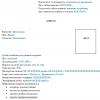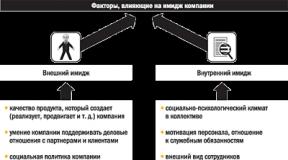How to quickly stop bleeding from a wound? What to do to quickly stop bleeding from a cut When the bleeding stops
Hematologist
Higher education:
Hematologist
Samara State medical University(SamSMU, KMI)
Education level - Specialist
1993-1999
Additional education:
"Hematology"
Russian Medical Academy Postgraduate education
When violated blood vessels due to various injuries, bleeding begins, which is also called bleeding. In case of profuse bleeding, it is important to immediately take measures to stop the blood, in many cases you can do this yourself. But there are also more difficult situations in which heavy bleeding cannot be controlled.
Types of bleeding and the reasons for their appearance
Rapid blood loss significantly reduces the amount of blood circulating in the body. This situation provokes a poor supply of oxygen to tissues, including the brain and other vital organs. If the wound is not too deep and bleeding is in moderation, but for a long time, the person begins to suffer from iron deficiency anemia... Bleeding is especially dangerous for the elderly and young children.
The consequences of bleeding largely depend on the degree of damage to the vessel and its size. Disturbances in small arteries and capillaries stop on their own in a fairly quick time, due to the formation of blood clots in them. If a large artery is damaged, the blood stream is so large that the person risks dying in a few minutes.
The types of bleeding depend on damage to various vessels, namely:
- Capillary;
- Venous;
- Arterial;
- Mixed.

Small bleeding is capillary, which spreads over the entire surface of the damaged area. If the vein is damaged, the blood stream is fairly uniform and has a cherry color. Arterial bleeding is quite serious, the flow of blood is very strong, it pulsates in accordance with the heartbeat. Mixed bleeding is characterized by signs of arterial and venous blood loss.
Often there are situations when bleeding begins from the mouth, this may be due to:
- Bleeding from the lungs, which begins with tuberculosis or lung cancer;
- Gastric bleeding, which occurs as a result of cancer of the stomach or esophagus, as well as as a result of an ulcer.
First aid
How to stop bleeding from a serious wound? In the case when the bleeding does not stop on its own or the person has received an injury to the head, abdomen, or chest and there is a possibility that they were hurt internal organs, you should immediately seek help from medical staff... Before you get a patient into the hands of specialists, it is important to provide him with first aid, which often saves life.
If the wound is minor and the bleeding is not too severe, then a sterile dressing made of cotton wool and gauze can be applied to it. All this can be fixed with a bandage or glued with an adhesive plaster. When applying such a bandage, make sure that it does not tightly squeeze the adjacent vessels, and the place under it does not turn blue.

If the wound is more severe and the bleeding is profuse, a gauze bandage will not help. In this case, it is necessary to find a place above the wound in which the pulsation of the artery is felt and pass it on with your own fingers or fist. In this way, you can stop the blood flow completely. It will not be possible to hold the artery tightly for more than 10-15 minutes, so during this time it is important to get to a medical institution where the victim will be assisted. If during this time such an opportunity does not appear, a tourniquet should be applied, which can be made from improvised means in the form of a belt, tie, and other things.
It is important to know where to apply the tourniquet correctly in case of various wounds. If the leg is injured under the knee, then a tourniquet is applied in the thigh area. If the arm is injured below the elbow, the tourniquet is tightened in the shoulder area. The injured limb needs to be wrapped soft cloth... A tourniquet is placed under the limb, taking it by the middle and end, while stretching. After that, it is wrapped around the desired area, tightening. The first turns tighten more, the subsequent ones should weaken. The turns are done next to each other so that the fabric does not get confused between them.
It is important to put a note under the tourniquet, which marks the hour and minute when it was applied. In a warm room, the tourniquet can be kept on the body for up to 2 hours, and in a cold one for up to 1.5 hours. If during this time the doctors did not help the victim, the tourniquet should be loosened by squeezing the damaged artery, left in this state for 5 minutes, and then the tourniquet should be applied again slightly above its previous location.
In severely injured limbs, you can stop the blood loss by bending them strongly. If the hand is injured in the area of the hand or forearm, a roller made of fabric or gauze is installed under the elbow bend. The arm should be bent so that it was possible to connect the shoulder and forearm with a belt or bandage. When the wound is located in the shoulder or clavicle, in this case, both limbs are brought behind the back and pulled tight at the elbows.

If the shin or foot is injured, the roller should be placed under the knee, bend the leg and pull the shin to the thigh. For wounds in the thigh area, the roller should be placed in the groin area and bend the leg towards the body. In any case, the affected limb needs to be raised and urgently seek help from a doctor.
Warning
If you became the one who provided first aid to the injured person or in connection with your professional activities there is a possibility of this, you should know a number of rules that are extremely important to follow:
- The use of a tourniquet is not always appropriate and is not recommended in all cases, but it so happens that such a technique for stopping blood loss can save a person's life, and it is important to remember this;
- Precautions must be taken to prevent the transmission of disease between you and the victim. If possible, create a barrier between you and the patient's open wound. This is easy to do with gloves or a clean cloth;
- After helping, wash your hands very thoroughly with soap and water. Do not use a kitchen sink for this;
- After treating a bleeding victim, do not touch your eyes, mouth, and nose until you wash your hands.
The following tips can be useful to each of us, because we never know in what situation we ourselves are at risk or who will have to provide the first and most important aid for bleeding. Here are some of these tips:
- If you squeeze the wound from which bleeding, do not release the pressure on it to check if the bleeding has stopped. Continue squeezing the damaged area until the doctor arrives;
- At arterial bleeding pressure on the entire area of the wound will not help, in this case it is necessary to transfer the desired place with your finger;
- If the victim is taking coagulants, then it will take more time and effort from you to stop the bleeding;
- If the injury is extremely serious, then it is better not to waste time on useless help, but rather call for help to get medical help;
- If severely injured in the abdomen, do not try to regain organs abdominal cavity back, cover them with a clean cloth and wait for the ambulance.
These simple tips will help save lives not only for yourself, but also for those who are in trouble before your eyes. It is important to remember that serious bleeding requires the fastest possible reaction and competent help, which is often able to save human life.
Cuts to a finger or toe are common in both adults and children. This is a condition in which the skin is damaged. Sometimes not only the cover is affected, but also the vessels, which causes the blood fluid to leak out. After a certain time, it collapses, and a wound remains in this place.
There are situations where the cuts are deep enough, which leads to severe bleeding. In this case, you need to know how to stop the blood from the finger and not provoke an infection into the wound. The choice of processing method will largely depend on the depth of the cut.
Urgent control of bleeding
To quickly stop the blood, you need to know how to do it, and it is also important to exercise proper care behind the wound so that it heals as soon as possible.

- With a minor cut, the applied adhesive plaster must be removed from the finger the next day, which will provide oxygen access to the wound, and it will begin to tighten faster.
- If it becomes necessary to carry out any work, then the damaged area must again be sealed or bandaged. This will prevent re-damage and infection.
- With the development of the inflammatory process, treat the cut with hydrogen peroxide or brilliant green. Some doctors advise against using iodine as it can cause burns.
With a deep cut, it is necessary to carry out daily dressings, it is important to first wash the wound with an antiseptic solution. Until the damage heals, you should refuse to visit the bath, take a bath and wash dishes.
Superficial cut
This injury can result from improper handling of a razor, blade, knife, or any other sharp object. The resulting wound can have different depths, which requires appropriate handling.
If you get a shallow cut, the bleeding will go away on its own after a few minutes. However, even in such a situation, certain recommendations must be followed:
.jpg)
- do not carry out activities that contribute to the rapid stop of the blood, since the existing bacteria and infection are released with it;
- you can use a stream of running water to wash the wound;
- after a certain amount of blood fluid has flowed out, the arm can be raised above the level of the head, which will ensure the outflow in a natural way;
- to disinfect the surface, apply treatment with hydrogen peroxide, especially if there is no confidence in the cleanliness of the object with which the cut was made;
- put a gauze pad on the wound, which is necessary to preserve the crust when changing the dressing;
- bandage the affected surface with a bandage, but do not pinch the vessels.
To process the edge surface of the cut, use brilliant green or iodine. It should be remembered that in no case should these solutions be poured into the wound itself.
Deep damage
With a severe cut, blood flows out of the wound more intensively. In this case, first of all, it is necessary to treat the wound, cleaning it from foreign objects getting inside.
The algorithm for cutting a finger will be as follows:
- the wound surface is washed under running cool water;
- treated with furacilin, hydrogen peroxide or other disinfectant;
- the hand rises above the head, which allows, if not to stop, then significantly slow down the bleeding;
- then an antiseptic bandage should be applied to the wound and bandaged.
If the cut is serious enough, there are also some guidelines to follow to make it possible to heal faster:

- To stop the bleeding from the finger, experts do not recommend making any movements with them. Thanks to this, the healing process will not be disturbed.
- Protect the damaged surface from water ingress. If you need to wash something, you need to wear a rubber glove. After contact with the liquid, the glove is removed and the bandage is replaced with a new one. If this is not done, then an ideal environment for the reproduction of pathogenic bacteria is formed.
- The dressing is changed every four hours; after several days, this can be done every three days at the most. It is important to remember about the preliminary treatment of the wound with disinfectants.
In some situations, wound stitching is required.
When the blood doesn't stop
If the bleeding does not stop for a long time, it is recommended to rewind with a thread at the base of the injured limb. Thanks to this manipulation, the blood vessels are pinched and blood stops flowing to the wound.
Such a tourniquet can be kept for no more than five minutes. Otherwise, the capillaries can be damaged and destroyed.
How to prevent infection if you cut yourself with a dirty object
We should not exclude situations when a toe or hand is damaged by something clearly dirty. This is most dangerous because the likelihood of infection increases. Here, the usual rinsing under running water will not help.

It is necessary to use a weak solution of potassium permanganate to treat the damaged site. After that, hydrogen peroxide is applied.
The resulting foam helps cleanse the wound from pathogenic bacteria and microbes.
The edges require additional processing with brilliant green. After carrying out these activities, a tight bandage is applied.
Cuts in children
V childhood it is not difficult to injure a finger, since little fidgets are in constant motion.
To stop a child's bleeding, adult remedies will not work. Not only do children already experience painful sensations, a burning sensation will also be added to them.
To treat the wound, experts advise using water-based medications.
The most common and effective means refers to Octenisept, which should be in every home medicine cabinet. In its absence, the use of old, but proven methods is allowed.

Traditional methods of stopping bleeding
You can also stop the blood from a cut at home traditional medicine... Most effective and safe method the use of a decoction made from pharmacy chamomile or oak bark is considered.
.jpg)
These plants can be used individually or together. Chamomile flowers have a disinfecting effect, and oak bark contains astringent elements that help stop blood.
No less popular is the method in which plantain is applied to the wound surface. You can also use burdock leaves. The peculiarity of these plants lies in the antiseptic and wound-healing effect.
It is important to remember that before applying the sheet to the cut, it must be washed well and several notches must be made to isolate the juice.
If there is no antibiotic at hand, calendula tincture will replace it. Healing decoctions can also be prepared from it. This plant prevents the development of severe inflammation.
In desperate situations, it is allowed to use a weak saline solution to wash the wound.
How to determine if a tendon is not affected
If the tendon is damaged, symptoms such as:
- inability to unbend or bend the injured finger;
- the presence of a visible end in the projection of a deep cut.
If there is even slight movement, it is most likely that the tendon was not affected. Pay attention to this on the first day of the cut when examining the wound.
When you need specialist help
You need to see a doctor when you can see in the cut:
- fatty layer;
- a fragment of a bone;
- muscle;
- torn edges.
In this condition, surgical intervention with suturing will be required. The victim must be transported to medical institution in a short time, maximum within six hours from the moment of receiving the cut. This will increase the chances of quick wound healing.
Rendering medical care is also required when the following symptoms appear:

- pronounced pain syndrome;
- persistent bleeding;
- pallor of the skin;
- puffiness or swelling;
- profuse sweating;
- chills.
In case of extensive injuries, it is forbidden to carry out cleaning activities using improvised means. Also, you cannot try to sew up a cut or glue it yourself.
In theory, everyone has an idea of what measures to take to stop the blood from cutting a finger. However, in reality, many people get lost and do not know what to do. The main thing in this case is not to panic, to act confidently and quickly..
With shallow cuts, it will not be difficult to quickly stop the blood from the wound.
It is important that the first aid kit contains all the necessary first aid equipment. If the cut is severe enough, it is best to see a specialist as some situations require surgery.
Often in everyday life, when cooking, sharpening a pencil or performing other manipulations at home, we get a deep cut on our finger. This is always unexpected, painful and annoying, in addition to all this, blood is coming from the finger and it must be stopped as quickly as possible. At home, you can always find improvised hemostatic agents, even if the blood does not stop. Although the nature and depth of the incision of the wound plays an important role. This is individual - from one accident to the next. You may need to see a surgeon for stitches.
This article - "How to stop bleeding from a finger" - will be useful for adults, parents of children, because often the child may need help at home. Consider how to treat a wound using home, folk and medical remedies.
How to stop bleeding from a deep cut in your finger at home quickly
Tips for stopping bleeding at home can be as follows, including haemostatic agents included in your home medicine cabinet:
- Hydrogen peroxide- an excellent antiseptic. When injuring a child, it is especially preferable to use this solution, since it does not burn or sting the wound. An alternative remedy is chlorhexidine, miramistin ... These new generation drugs are in no way inferior to hydrogen peroxide.
- Solution potassium permanganate(potassium permanganate) pale pink (not concentrated). It is good for them to water the wound abundantly to remove dirt and pathogenic microbial flora. It will cleanse the wound, dry it and improve the regeneration processes.
- Solutions brilliant green(brilliant green) and iodine more suitable for the treatment of the edges of the wound, rather than the very wound surface. They give a painful burning sensation and discomfort when applied, but, nevertheless, they sanitize the wound.
- Gauze napkins, cotton pads and bandages (plus adhesive plasters) in sterile form will help close the wound well from an infection flying in the air. It is advisable to replace the sterile dressing with a new one every three hours.
Attention! Be sure to line the treated edges of the cut together for better closure and regeneration, this will speed up the healing and healing process of the wound.
If the blood does not stop ...
If the blood does not stop for a long time, profuse bleeding is accompanied by pulsation in the wound of the finger, especially since bone or tendons are visually observed, the damaged finger becomes numb - immediately contact medical help.
Which doctor to go to - a surgeon, traumatologist, ambulance paramedic.
After all, surgical intervention may be required if the nerve trunks, tendons, muscle fibers are damaged. You need to save your finger and save its functions!
Shallow cuts
In everyday life and at work, you can cut yourself with anything: glass, a shard of a mirror, a knife, or any sharp object. Wounds are of varying depth and severity.
When the wound is shallow, the bleeding can be stopped on its own within five to ten minutes. Hematopoietic ability to thicken, form a blood clot, a natural self-preservation mechanism.
What to do: providing first aid to yourself and your child
However, you need to know certain rules - the first aid algorithm for cuts:
- Do not try to quickly stop the blood, because it flushes out all the bacteria that have got in the wound, foreign bodies and infection.
- Rinse your finger with a gentle stream of cool water, perhaps a little soap.
- After the discharge of blood from a cut on the finger, raise your hand above your head and shake it for a few minutes, you will be amazed at how to close the edges of the wound on your own, the blood will stop flowing.
- Next, treat the wound with hydrogen peroxide to decontaminate the surface, especially if the sharp object is rusty or simply dirty.
- Apply a gauze bandage (bandage) soaked in hydrogen peroxide to the wound itself so as not to rip off the resulting "crust" when changing the dressing in order to prevent re-bleeding.
- Bandage with a sterile bandage (or just a clean one from the package) without pinching the vessels tightly so that the bandage is tightly held.
What not to do
- Do not pour alcohol on the wound - 40% - it irritates the skin, but does not kill all germs. 96% alcohol causes burns and a crust on the wound, but cannot disinfect deeply. Better to use 70% ethanol, but just not on small children, because he calls out an intense burning sensation and pinching.
- Do not pour a solution of brilliant green or iodine on the wound itself. They process the edges of the cut.
Severe cuts
With a deep - strong cut, the bleeding will always be intense. First, treat the wound surface, remove all foreign objects from it - dust, dirt, etc.
What do we have to do
The algorithm of actions for a deep cut is as follows:
- rinse the wound under cool water. If the wound is contaminated, be patient and apply soap;
- treat the wound with a solution of hydrogen peroxide - it will clean the cut well;
- alternative washing: solution of potassium permanganate, furacilin;
- raise your hand above your head, shake it to reduce blood flow to the hand, this will reduce bleeding, or even stop it completely;
- if the blood does not stop, rewind tightly the base of the injured finger with a thread, this will help pinch the blood vessels and reduce the flow of blood to the wound, remove the thread after three to four minutes so as not to damage the finger vessels;
- apply a sterile gauze bandage to the wound surface, saturate it with an antiseptic (furacilin), if the blood continues to ooze, appears on the surface of the bandage, apply a few more layers of the bandage, the bandage needs to be changed every three to four hours.
With a deep cut, several rules must be followed for quick wound healing:
- Do not make active movements with the injured finger.
- Do not wet an injured finger with a cut. If it is not possible to avoid getting wet, use rubber gloves, a finger rest. Remove rubber gloves and change to dry dressing immediately after contact with water.
- Change the bandage at first every 3-4 hours, then at least 3-4 times a day. Each time treat the wound with an antiseptic, you can apply tetracycline ointment to the wound.
Sometimes you have to suture in the surgeon's office, then the dressing is done for the first few days in the clinic or hospital, then it can be changed at home.
Folk home remedies
Use folk remedies, recipes of traditional healers, if you are far from home and "civilization". However, when returning home, see your doctor and use medication.
- Decoction chamomile or oak bark- natural antiseptics that can be used together or separately. Pharmacy chamomile disinfects, has anti-inflammatory properties, oak bark, due to strong tannins and astringents in its composition, has a good disinfecting and astringent effect.
- Infusion or decoction calendula flowers- a natural antibiotic that relieves strong inflammatory processes.
- Plantain leaves, burdock- have antiseptic and wound healing properties. Before use, plant leaves must be rinsed under running water. Before applying to the wound, the sheets must be crumpled in the hands so that the juice is released.
- Wood ash – good remedy for the treatment of wounds, deep cuts, burns and abscesses. Better to apply in medicinal purposes ash of deciduous trees.
- Weak solution table salt(1 teaspoon for one glass of 200 ml. Water), although it causes a burning sensation, it draws out all the filth from the wound well.
- Curry seasoning Is an Indian recipe for treating wounds, which disinfects the wound surface well and kills pathogens.
- Products beekeeping – honey with bee bread, wax, propolis ... Honey, like propolis, has a pronounced antimicrobial activity, you can smear a wound, it will heal well.
Video
How to quickly stop bleeding in minor wounds and cuts
Video channel "Useful And Interesting".
Review: it helped a lot thanks, it worked in 40 seconds. Although it may be better to apply hydrogen peroxide or a styptic wipe.
On the video channel "Zalivaha". It happened to me to cut myself very badly for the second time in my life. I decided to make a video about recommendations for stopping blood from the fingers of the left hand in a domestic environment.
Review... Excellent recommendations, I would suggest shooting the second part of the safety video when working with a cutting tool! The knife lover himself with experience, plus I like to cook, and most importantly - a professional wood carver. I haven’t cut for 15 years already, using just one rule: in the direction of the cutting tool MUST NOT BE my meat! If this rule is violated, I go from the other side, turn the workpiece over, change the position, but I cut only from myself! Good luck to everyone and like the vidos of course.
What to do if you cut off a piece of your finger
On the video channel "MozgON".
How to treat a wound if you cut off a piece of your finger (skin with meat)?
First, it is best to contact medical Center, a hospital where your wound will be properly treated, bandaged.
If you are in a forest, a village, on a desert island, or some other circumstance, you will have to do everything yourself.
Trauma is common - a lot of blood goes away, your head is spinning, pain, you worry awesome - what will happen next, in general the situation is lousy.
To stop blood and care for the wound, you need:
- Hydrogen peroxide;
- Streptocide (powder) or gentamicin, baniocin - ointments.
- Patch;
- Bandage.
The sequence of actions (especially important for someone who has a piece of finger cut off irrevocably):
- We swear loudly, shout (relieve stress).
- We disinfect the wound with hydrogen peroxide - we just pour it on the wound - it hurts, the wound hiss, blood flows. We do not regret the peroxide - we just pour it.
- We fill the wound with streptocide (just pour the powder onto the wound site).
- We make a small pillow out of the bandage (we fold the bandage 4 times), or use a cotton pad.
- We attach the pad to the wound site with a plaster, wrap it with a bandage.
After - you need to calm down! I personally took a cool shower (I kept my hand away from the water), and drank tea and coffee. Helps also fast walk.
After half an hour - an hour, when the blood stops, you can unwind the wound again, and there, if you wish, either fill it with peroxide (I personally poured it again, it hurts unpleasantly), and then apply gentamicin ointment, or immediately apply the ointment.
Gentamicin, Baniocin are antibiotic ointments that kill germs. If you don’t make a layer of ointment or leave space, then when you dress the wound, it will give you excruciating pain to tear off the bandage that has grown together with the body tissue!
I made a large layer of ointment - 2 mm of height above the wound was, maybe even more - the ointment is applied inconveniently, it is somewhat hard, so it needs to be gently (very painful) smeared over the wound and sealed with a plaster so that a layer of ointment remains between the wound and the plaster - this is intuitive, since I don't want to touch the wound with anything.
And so we live for a week, changing the bandages 2 times a day, morning and evening. To wash on your hand, put on a plastic bag.
I bought a lot of wide band-aids right away. After a week (maybe even earlier), I stopped putting the ointment, and after a couple of days, there was just a wound that looked like dried eggs of red caviar - but it didn't bother me anymore.
I think it will take 3 weeks to fully recover.
How to properly treat a wound, how to clean a wound - Ambulance Doctor Komarovsky
We already know how to stop bleeding. After the bleeding has stopped, the wound must be cleaned. This is what Dr. Komarovsky will tell you about: how to clean the wound and what is the best way to treat it. Are traditional iodine, brilliant green and hydrogen peroxide really necessary? In what cases can you not do without a doctor and what to do if you do not know if a person is vaccinated against tetanus?
So we looked at bleeding with a deep cut in a finger and how to quickly stop the blood at home if it does not stop.
Here are some signs Bleeding Cuts or Wounds a wound that needs to be shown to a doctor. In some cases, your life may depend on it. Don't hesitate.
- The cut looks deep, is bleeding profusely, and you cannot stop the bleeding for 10 minutes. There are no options here: either urgently contact the emergency room, or call an ambulance.
- The wound can be described with the word "gaping". The cut is deep and wide enough, or has ragged edges.
- A deep cut is located on the face. Even if it is safe, it can leave an unaesthetic scar if it is not stitched in time.
- You have been bitten by an animal or person. If you were tapped pet and the scratch is small, most likely there will be no trouble. But if we are talking about a bite of an unfamiliar living creature, it is better to see a doctor. after the onset of symptoms is already incurable Rabies and 100% deadly. But if you get vaccinated on time, death can be avoided.
- A scratch or cut was taken outside, dirt got into the wound, and you don't have a tetanus shot. Either there is a vaccination, but more than 10 years have passed since the vaccination. Tetanus pathogens enter the wound with dirt. The prognosis is more friendly than with rabies: in the absence of timely treatment die Eradication of tetanus up to 80% of cases, and not all 100%. But whether you are lucky is another question.
- The wound was inflicted by a nail. Especially rusty Deep cut first aid... These puncture wounds are the most dangerous in terms of tetanus.
- There are signs of infection. Reddened hot skin, swelling, purulent discharge from the wound, fever, red streaks under the skin in the area of the cut - all this indicates an infection. There is a chance that the body will cope on its own. If not, you're in danger. It is lethal, if that.
However, no matter how dangerous or safe a cut is, first aid begins with the same step. You must stop the bleeding. Well, or at least try to do it.
How to stop bleeding from a small cut and what to do next
A short guide Cuts and scrapes: First aid to care for small cuts and looks like this with scratches.
1. Wash your hands
It is important not to infect the wound. Soap and water, hand sanitizer gels, and wet wipes will do. You can also wear sterile medical gloves if available.
2. Stop the bleeding
For minor cuts or scrapes, the bleeding usually stops quickly on its own, so you can skip this step. If blood still leaks, place a piece of clean gauze or other cloth over the wound and press down slightly. Leaving the bandage on for a minute or two is often enough.
If you don't have gauze at hand, you can use the old-fashioned method - put a plantain leaf washed with water and slightly crumpled (to let the juice out) on the wound. The sap of this plant contains astringent substances that, in theory, help stop bleeding. But there is still no unequivocal evidence for this: more research is required.
Another life hack: to stop the bleeding, raise the injured arm or leg (if they are cut) above the level of the heart.
Attention: if intense bleeding does not stop within 10 minutes, we recall the beginning of the text and urgently seek medical help.
3. Rinse the wound with water
Naturally clean. The best option is warm water and soap.
Caution: Do not use hydrogen peroxide or iodine. These products can cause additional irritation.
4. Carefully remove dirt and debris from the wound
Most often, they are washed out with water at the previous stage. If any lumps of dirt still remain, try removing them with alcohol-treated tweezers.
Caution: If large splinters are involved or if effort is required to remove dirt, leave them alone. Overdoing it and still pulling out the excess, you run the risk of provoking new bleeding. And it's not a fact that it can be stopped just as easily. In this case, the wound should be treated by a surgeon or doctor on duty at the emergency room.
5. Apply antibiotic ointment or petroleum jelly to the wound
Warning: Sometimes the ingredients in the ointment can cause a mild rash. If you notice this in yourself, stop using the particular tool. And check with your therapist: he will suggest a safer option.
6. Cover the cut with a bandage.
It will protect the wound from new bacteria. If you hurt your finger or, for example, your hand, it is convenient to bandage them. If a wider part of the body is affected, apply a gauze bandage and secure it with adhesive tape. Change the dressing 1-2 times a day until the wound heals.
Most cuts and scrapes will heal completely Taking Care of Cuts and Scrapes: The Basics in 7-10 days.
Caution: If the cut or scratch is very small, leave it open - it will tighten faster.
7. Watch the wound
If there are signs of infection (listed at the beginning of this text), see your doctor.
Warning: do not ignore the infection. It is important.
How to stop bleeding from deep cuts and what to do next
Deep cuts are already dangerous. Large blood vessels can be affected, which increases the risk of serious blood loss or blood poisoning. It is impossible to self-medicate in such cases. So proceed like this.
1. Call your doctor
If the cut is bleeding profusely and / or is causing the person significant pain, call an ambulance. If the situation seems to be under control and generally bearable, go to the emergency room or try talking to your GP or surgeon over the phone.
2. Try to stop the bleeding
This should be done while you are waiting for an ambulance or preparing to go to the emergency room. Rinse the wound quickly with water (soap is good) to wash away any debris, then apply a pressure bandage if there are no large debris left in the cut. A piece of clean gauze or cloth will need to be held over the cut for about 5 minutes. Don't take it off before First AID: how to treat a cut: you can rip off a newly formed blood clot and the bleeding will only worsen.
If there are still large fragments in the wound and it was not possible to wash them off with water, do not try to pull them out - this can intensify bleeding. Let the doctor take them out (who is already coming to you or to whom you are in a hurry on your own). To reduce the bleeding, in this case, you can:
- Raise the affected body part above the level of the heart.
- Apply to the injured limb - 7-10 cm above the wound. Pharmacy harnesses and turnstiles can be used, as well as homemade ones - for example, a belt or a twisted T-shirt. Mark the time of application of the tourniquet (with the same marker on the skin). You have 1-2 hours to see a doctor.
3. If the bleeding was stopped, treat the wound with an antiseptic ointment.
Do not go deep into the cut; just work around the edges. Then apply a sterile cloth to the wound - a bandage or gauze.
4. Wait for an appointment with your doctor
Let us remind you again: for a deep cut, it is required.
How can you stop the blood, disinfect the wound, and what to do if there are no medicines at hand? You can get answers to these and other questions from this article.
How to stop bleeding from a small cut
- Rinse the bleeding wound with clean water to remove any debris. Remove anything from the cut that could lead to infection, such as clothing, jewelry, or shoes.
- Disinfect the wound. Of course, it is best to use pharmacy medicines: hydrogen peroxide, chlorhexidine or brilliant green. Alcohol, vodka or iodine may also be suitable for disinfection, if the use of such agents leads to a longer healing of the cut. If there is nothing else at hand, then they will do.
- Now it is very important to protect the wound from getting into it. If the cut is small, then it can be sealed with a special plaster, but for more serious injuries, it is appropriate to use a bandage or gauze.
- Do not bandage the wound too tightly. Circulating air will help the blood stop faster, making the cut more likely to heal.
If you notice that over time the cut has begun to swell or acquire an unnatural color, then you should immediately consult a doctor. Infectious contamination is possible.
How to stop bleeding naturally
In the event that you have cut yourself somewhere on the street, and there are no medical supplies at hand, use natural methods of treatment.
Plantain
This plant has excellent antiseptic properties and promotes rapid healing of bleeding wounds.
Before applying plantain to a cut, it must be rinsed and crushed until the juice begins to stand out from it.
Web
If you are injured somewhere in the forest, then you will be able to stop by means of a spider web applied directly to the site of the wound.
Bread crumb
Take a piece of pulp from the middle of a loaf of bread or roll, lightly dampen it in water and place it on the wound. Very soon, the blood will start to stop.
As soon as possible, be sure to treat the wound with an antibacterial medicine to avoid infection.
How to stop bleeding when deep cuts are made
- The first step is to assess the extent of the cut. If layers of skin, fat and / or skin are visible, seek professional medical attention immediately.
- While you are waiting for the arrival of doctors, take a position in which the damaged area will be above the level of the heart. This will make the blood pressure lower in the affected area.
- Don't try to overtighten the wound immediately. The blood flowing out of it helps to cleanse it.
- Use some kind of antiseptic to treat the edges of the wound, and put a sterile piece of bandage or gauze over the cut itself.
What are you doing to stop the bleeding? Which methods help you the most, and how often do you apply for professional help about this question? Write about it in the comments.
Well, now you know how to stop the bleeding. We hope that this knowledge will never be useful to you, but still every adult should know at least the theory.
If you like it at all - subscribe to the site InteresnyeFakty.org... It's always interesting with us!



















